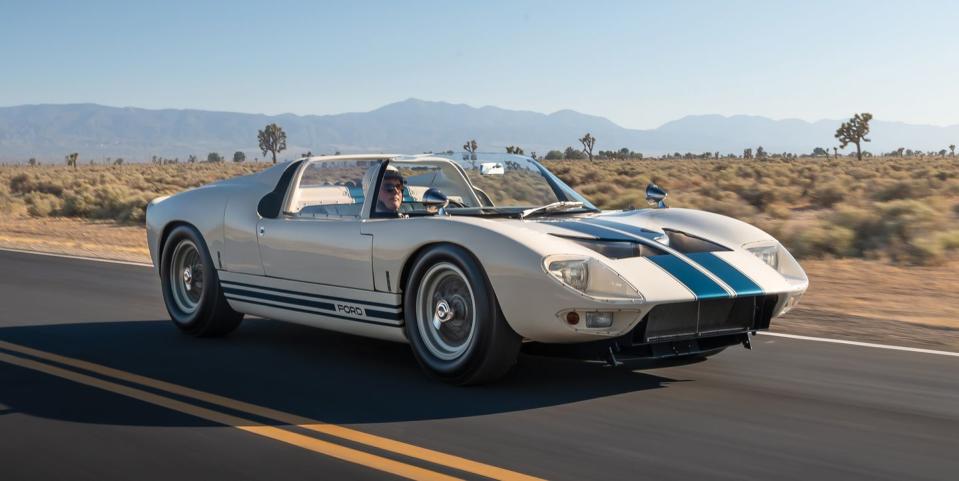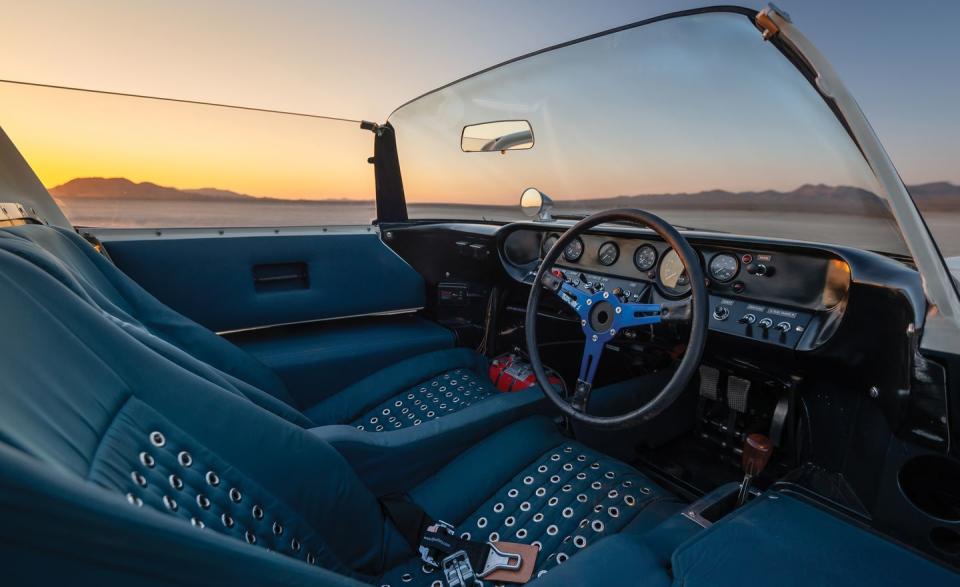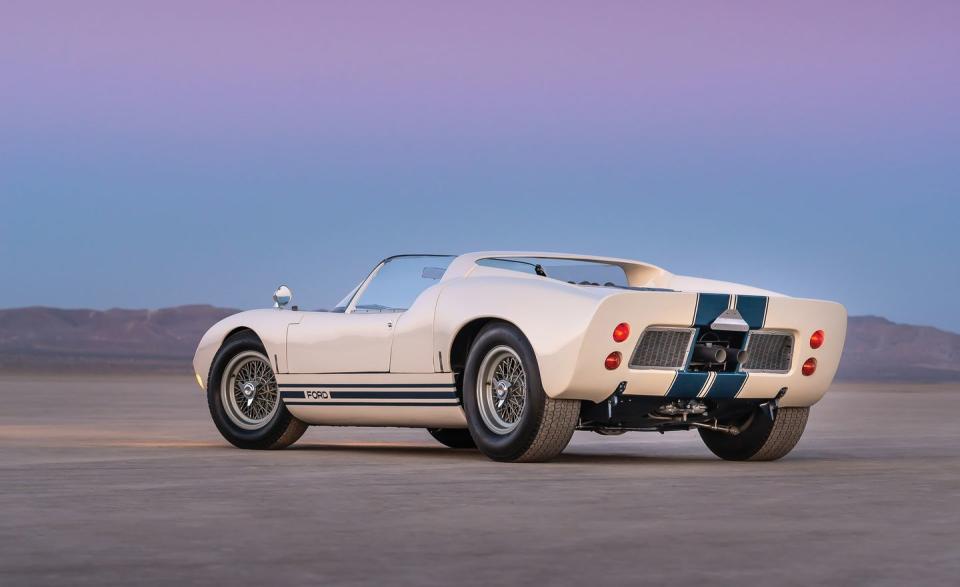54 Years after We Drove This Ford GT40 Roadster, It's Being Auctioned for Millions

RM Sotheby's will auction a 1965 Ford GT40 roadster prototype in Monterey on Friday, August 16, and it's expected to go for millions.
Interestingly, this is the very same GT40 Car and Driver tested for our November 1965 issue.
The winning bidder is welcome to invite C/D over to test the GT40 again.
Everyone has those moments when they're reminded of their age. Maybe you caught a few scraggly gray hairs poking out of your nose, or you realized that your high-school dream car is now old enough for historical or vintage license plates. Our latest reminder that Car and Driver is a mature entity came when we noticed that RM Sotheby's is auctioning off a rare 1965 Ford GT40 roadster at the 2019 Monterey Car Week—one that we reviewed 54 years ago.
Look, we're not trying for a low-key flex here by mentioning that we've been around for over 60 years expertly critiquing the automotive industry. (But, hey, as a reminder, we have been.) We're mentioning this GT40's Car and Driver link because the story behind the story involves Carroll Shelby; Ford's frantic push to beat Ferrari at the 1966 24 Hours of Le Mans after sputtering failures in '64 and '65; an incredibly rare GT40 prototype; and Ken Miles, one of the Ford Le Mans drivers. With that car set to sell for millions of dollars on Friday, August 16, at the auctions surrounding this year's Pebble Beach Concours d'Elegance festivities, we felt now is as good a time as any to delve into our connection to it.
An Invitation from Carroll Shelby
We are one of only two publications to have been given original access to this Ford GT40 prototype (the other was Sports Car Graphic), and that access came from none other than Carroll Shelby himself. It was his beckoning that landed former editor Brock Yates in the GT40 prototype's driver's seat during a summertime testing session at Riverside Raceway in 1965. On hand for assistance? Ken Miles, one of the drivers who'd later help bring Ford the checkered flag in the '66 Le Mans race in the automaker's famous 1-2-3 photo finish. Also present was his mechanic.

Miles was at Riverside testing the GT40 roadster, of which only three existed at that time. The chassis, GT/108, had been built by Ford Advanced Vehicles in England and delivered to Shelby American for completion in early 1965. Shelby installed a 289-cubic-inch Ford V-8, a Colotti four-speed manual transmission, and Borrani wire wheels on the topless, right-hand-drive Mk II GT40.
Ford had begun shifting its Le Mans strategy around that time, effectively giving outside control over its GTs' development to Shelby American after the car fell flat in 1964 and 1965 races. In a separate piece on the GT40 program we published in June 1965, we noted that the transfer of the GT program to Shelby made all the sense in the world: The man and his budding performance outfit had created the insanely successful Cobra race car, plus it had turned the Mustang into a racing success. Shelby also was based in Southern California, a much more consistent testing venue than seasonal Dearborn, Michigan. And, we noted, nearby Riverside raceway was far, far away from European racetracks, where rival Ferrari might sniff out Ford's game in the lead-up to Le Mans. Hence how we ended up at Riverside on a steamy hot spring day, with Ken Miles and GT40 no. 108.
Don't Meet Your Heroes
Ken Miles was both a development driver and one of Shelby's racers, and he was a gifted fellow. He also was surprisingly hands off with our Brock Yates, even though he had been instructed to let this journalist loose on a sun- and oil-soaked Riverside Raceway in a 385-hp racing prototype. As Yates wrote later, "I tugged on my coveralls and buckled my helmet with two things in mind: don't do anything dumb and don't try to be a hero."

After running through the basics of the GT40's limited switchgear and how the Colotti gearbox preferred double-clutching on both up- and downshifts (clutching in, moving the shift lever to neutral, clutching out, then clutching in again before selecting the new gear and rev-matching the engine), Miles sent Yates off. "I guess that does it, you'll find the starter button on the tunnel beside your left knee. Have fun."
We'll let you read Yates's impressions of the GT40 for yourself, but one conclusion deserves a callout here: The lack of a roof proved annoying. It's little wonder so few GT40 roadsters were built; sure, it was hot in California during his testing session—but imagine running an open-topped car (as was common back then) at Le Mans, where it often rained, for 24 hours at a time. Only eight roadsters were ever built, and GT/108 is, according to RM Sotheby's auction house, the only one to have "continually survived in its original form."
Stayin' Alive
GT/108 survived in part because it was socked away shortly after its useful life as a test bed for Ford's later Mk IV '67 Le Mans racers and as a promotional prop ended in the late '60s. It was briefly used by a Milwaukee, Wisconsin Ford dealership, as a promotional attraction before being returned to Kar Kraft and sold to one of its employees in 1969, who converted it to road use. (The car lost its Colotti gearbox in favor of a more streetable ZF transmission and a fresher 289 V-8, both pulled from Ford's Mach 1 concept.) In the decades since, it has changed hands a number of times. It also appeared at the Pebble Beach Concours d'Elegance, where it won a class award in 2003 and was shown in 2017 and 2018. Mostly, it has lived a life of relative leisure, and it has long been restored to its original form.
Ken Miles didn't fare as well. After driving a 7.0-liter GT40 Mk II to what was to be a first-place finish at the 1966 Le Mans 24 Hours, he was cheated out of the win due to a Ford PR stunt that, in the winding moments of the race, called for the three GT40s set to finish ahead of everyone else to cross the finish line in formation. Miles, in the leading car, needed to slow up in order to fall into that famous formation. Trouble is, Le Mans finishing placement is based on the distance a car travels in 24 hours, not which car crosses the finish line "first." In asking Miles to slow down, Ford's PR apparatus denied him the necessary distance within that time frame to snatch victory, relegating him and co-driver Denny Hulme to second place. Things didn't exactly improve from there. At Riverside almost exactly one year after our outing with him, Ken Miles tragically died while testing an early '67 GT40 Mk IV prototype. However, as in '66, Miles' involvement in the GT program helped net Ford yet another victory at Le Mans in '67.
So, in GT/108, you have the Miles connection, the Le Mans connection, and the inherent rarity in one of the few GT40 roadsters ever built. That's an intoxicating mix. As RM Sotheby's, the auction house responsible for the car's latest sale, puts it: "Ideal for further concours display or vintage event use, this important prototype roadster claims rarity and historical connections with several racing luminaries. It would crown most any sports car collection, offering an indelible component of the GT40 legend for Ford connoisseurs and Le Mans enthusiasts alike."
Now, of course, you also know that the car has a historical connection with us. Keep that in mind if you're one of the lucky few planning on bidding on this car—we'd love to take it for another spin at Riverside, just maybe not when it's incredibly hot outside.
You Might Also Like

 Yahoo Autos
Yahoo Autos 